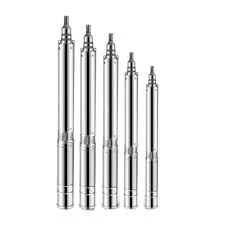Dec . 05, 2024 11:36 Back to list
Understanding the Operational Mechanics of Deep Well Pumps and Their Efficiency
Understanding the Working Principle of Deep Well Pumps
Deep well pumps are essential components in various applications, particularly in agriculture and municipal water supply systems. These pumps are specifically designed to extract water from deep underground sources, making them suitable for regions where groundwater is not easily accessible. This article explores the working principles of deep well pumps, highlighting their design features, operation mechanisms, and applications.
Design Features of Deep Well Pumps
Deep well pumps are typically submersible, meaning they are installed below the water level in wells. A typical deep well pump consists of several key components a motor, impellers, a pump bowl, and a discharge head. The motor is usually an electric or diesel-driven device that provides the necessary power to operate the pump. Impellers are rotational components that move the water through the pump, and the pump bowl houses these impellers to create a pressure difference that enables water to rise.
The length of deep well pumps varies based on the depth of the water table. These pumps can operate at depths ranging from 25 feet to over 1,000 feet, making them versatile for different well depths. Additionally, deep well pumps are often crafted from durable materials such as stainless steel or brass, ensuring they can withstand harsh conditions and resist corrosion.
Working Mechanism
The operation of a deep well pump can be best understood by examining the process of lifting water from underground sources. When the pump is activated, the motor begins to rotate the impellers. This rotation creates a centrifugal force, drawing water into the pump through the intake screen.
deep well pump working principle

As the water enters the pump, it is directed into the impellers. The design of the impellers allows them to increase the velocity of the water. As the water moves through the impellers, it gains kinetic energy. The pump bowl then converts this kinetic energy into pressure energy, causing the water to rise through the pump and eventually reach the surface.
The discharge head is the final component through which the water exits the pump. It is positioned above the ground and allows the pressurized water to flow into a pipeline, storage tank, or directly into the distribution system. Depending on the design, deep well pumps may also include features such as check valves to prevent backflow and controls to regulate the flow rate.
Applications of Deep Well Pumps
Deep well pumps are used in various applications due to their ability to access groundwater from considerable depths. One of the most common uses is in agriculture, where they provide irrigation water for crops. Farmers rely on deep well pumps to ensure consistent water supply, particularly in arid regions where surface water is scarce.
Municipal water supply systems also utilize deep well pumps to provide drinking water to communities. These pumps are critical in regions where the groundwater is the primary source of water. Additionally, deep well pumps are employed in industrial applications, such as mining and construction, where water needs to be drained from deep excavations.
Conclusion
Deep well pumps play a pivotal role in water extraction from underground sources. Their innovative design and effective working principle allow them to operate efficiently even in challenging conditions. By understanding the mechanics of deep well pumps, users can better appreciate their importance in agriculture, municipal supply, and various industrial applications. Moreover, as water scarcity issues continue to rise globally, the significance of deep well pumps is only expected to grow, making advancements in this technology essential for sustainable water management.
-
Submersible Water Pump: The Efficient 'Power Pioneer' of the Underwater World
NewsJul.01,2025
-
Submersible Pond Pump: The Hidden Guardian of Water Landscape Ecology
NewsJul.01,2025
-
Stainless Well Pump: A Reliable and Durable Pumping Main Force
NewsJul.01,2025
-
Stainless Steel Submersible Pump: An Efficient and Versatile Tool for Underwater Operations
NewsJul.01,2025
-
Deep Well Submersible Pump: An Efficient 'Sucker' of Groundwater Sources
NewsJul.01,2025
-
Deep Water Well Pump: An Efficient 'Sucker' of Groundwater Sources
NewsJul.01,2025
-
 Submersible Water Pump: The Efficient 'Power Pioneer' of the Underwater WorldIn the field of hydraulic equipment, the Submersible Water Pump has become the core equipment for underwater operations and water resource transportation due to its unique design and excellent performance.Detail
Submersible Water Pump: The Efficient 'Power Pioneer' of the Underwater WorldIn the field of hydraulic equipment, the Submersible Water Pump has become the core equipment for underwater operations and water resource transportation due to its unique design and excellent performance.Detail -
 Submersible Pond Pump: The Hidden Guardian of Water Landscape EcologyIn courtyard landscapes, ecological ponds, and even small-scale water conservancy projects, there is a silent yet indispensable equipment - the Submersible Pond Pump.Detail
Submersible Pond Pump: The Hidden Guardian of Water Landscape EcologyIn courtyard landscapes, ecological ponds, and even small-scale water conservancy projects, there is a silent yet indispensable equipment - the Submersible Pond Pump.Detail -
 Stainless Well Pump: A Reliable and Durable Pumping Main ForceIn the field of water resource transportation, Stainless Well Pump has become the core equipment for various pumping scenarios with its excellent performance and reliable quality.Detail
Stainless Well Pump: A Reliable and Durable Pumping Main ForceIn the field of water resource transportation, Stainless Well Pump has become the core equipment for various pumping scenarios with its excellent performance and reliable quality.Detail
